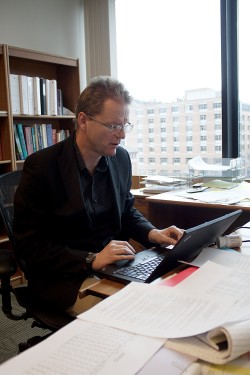The Portland State Budget and Planning Office forecasts a deficit of just over $23 million in the 2014–15 fiscal year if nothing is done to reduce expenses and increase revenue. In a budget forum on Feb. 29, Monica Rimai, vice president of finance and administration, and Kevin Reynolds, vice provost for academic fiscal strategies and planning, gave a presentation that detailed PSU’s financial position and ways to tackle the upcoming budget shortfall.
University facing $23 million budget deficit in 2014–15
The Portland State Budget and Planning Office forecasts a deficit of just over $23 million in the 2014–15 fiscal year if nothing is done to reduce expenses and increase revenue. In a budget forum on Feb. 29, Monica Rimai, vice president of finance and administration, and Kevin Reynolds, vice provost for academic fiscal strategies and planning, gave a presentation that detailed PSU’s financial position and ways to tackle the upcoming budget shortfall.

Current figures for PSU’s financial position show that for the 2011–12 fiscal year, total expenditures exceeded total revenue by almost $1 million. Because of an ending fund balance of more than $53 million at the end of the 2010–11 fiscal year, PSU is not expected to experience an immediate budget shortfall.
However, according to the statistics presented at the forum, if nothing is done to increase revenue and decrease operating costs, PSU may enter a pattern of decreasing fund balances at the end of the next three fiscal years, leading to the projected $23 million budget shortfall in fiscal year 2014–15.
Recent declines in state funding have a lot to do with the decreases in revenue, but additionally, PSU’s revenue this year slowed down with respect to increases in tuition. Rimai said that although enrollment had at least been steady, the student credit-hour production flattened out as students lowered their course loads to compensate for the most recent tuition hike. “That 9 percent perhaps was too high,” Rimai said.
PSU experienced not only decreases in revenue, but also significant increases in personnel expenditures. From 2010–11, PSU saw an increase of more than $15 million in personnel expenditures. Although these increases are due partly to salary increases, the biggest component comes from costs associated with benefits like retirement and health care.
According to Rimai, for now, increases in personnel-related costs would increase no matter what kind of salary adjustments were made. She strongly supports investment in human resources because, she said, “that is the most important resource we have in this organization.”
Reynolds acknowledged that the current model, which attempts to predict conditions through 2014–15, makes “a number of assumptions.” Among them are the assumptions about future state appropriations, which are unknown, and future increases in tuition, which are not included.
Rimai and Reynolds emphasized that PSU would have to be very strategic to reduce its operating budget while maintaining credit-hour productivity. Simply increasing tuition is an unlikely solution to budget issues, according to Reynolds, who said that fixing the problem “really has to be a mixture of some tuition increases, some enrollment increases, student hour-credit production and reduction in expenditures.”
In a Feb. 24 memorandum from the university budget team addressed to President Wim Wiewel and university vice presidents (available on the Budget and Planning Office website), five principles are identified “to guide the development” of the budget plan. They include increasing student retention and completion rates, expanding research productivity with external funding, providing widespread educational opportunities to potential students, using resources effectively and expanding PSU’s resource base “through strategic enrollment, philanthropy and external research funding.”
More specifically, the memo addresses the need to reduce operating costs for education and general expenditures funds by about 4 percent to balance the budget by 2014–15. To accomplish this, each unit is being asked to assemble a prioritized list of ways to reduce operating expenses by 4 percent, and also to identify what the consequences of those measures would be.
“We don’t want to cut our budget in a way that actually undermines our ability to generate revenue,” Rimai said.
Suggestions to increase credit hour productivity have included offering more classes outside of the Monday through Thursday, 10 a.m. to 2 p.m. time slots, and putting more focus on PSU’s summer term. The budget team has suggested retirement incentives as one way to generate salary savings, which Rimai declined to comment on “until it has passed muster.”







No comment on Perfomance-Based Budgeting? ‘Cuz I’m pretty sure that’s something they’re looking at.
Don’t know about PBB? Check out the details here: http://www.asccc.org/sites/default/files/PBFunding.pdf
Wonder why I think they’re focused on this as a way to go? Because it was *in* the slide show that Dear. Ms. Rimai gave, and second bullet point on the CV of the first candidate for Provost (Valarie Hardcastle) is “Transitioned College to performance-based (responsibility-centered) budgeting”.
I look forward to hearing what the Vanguard has to say about that one.